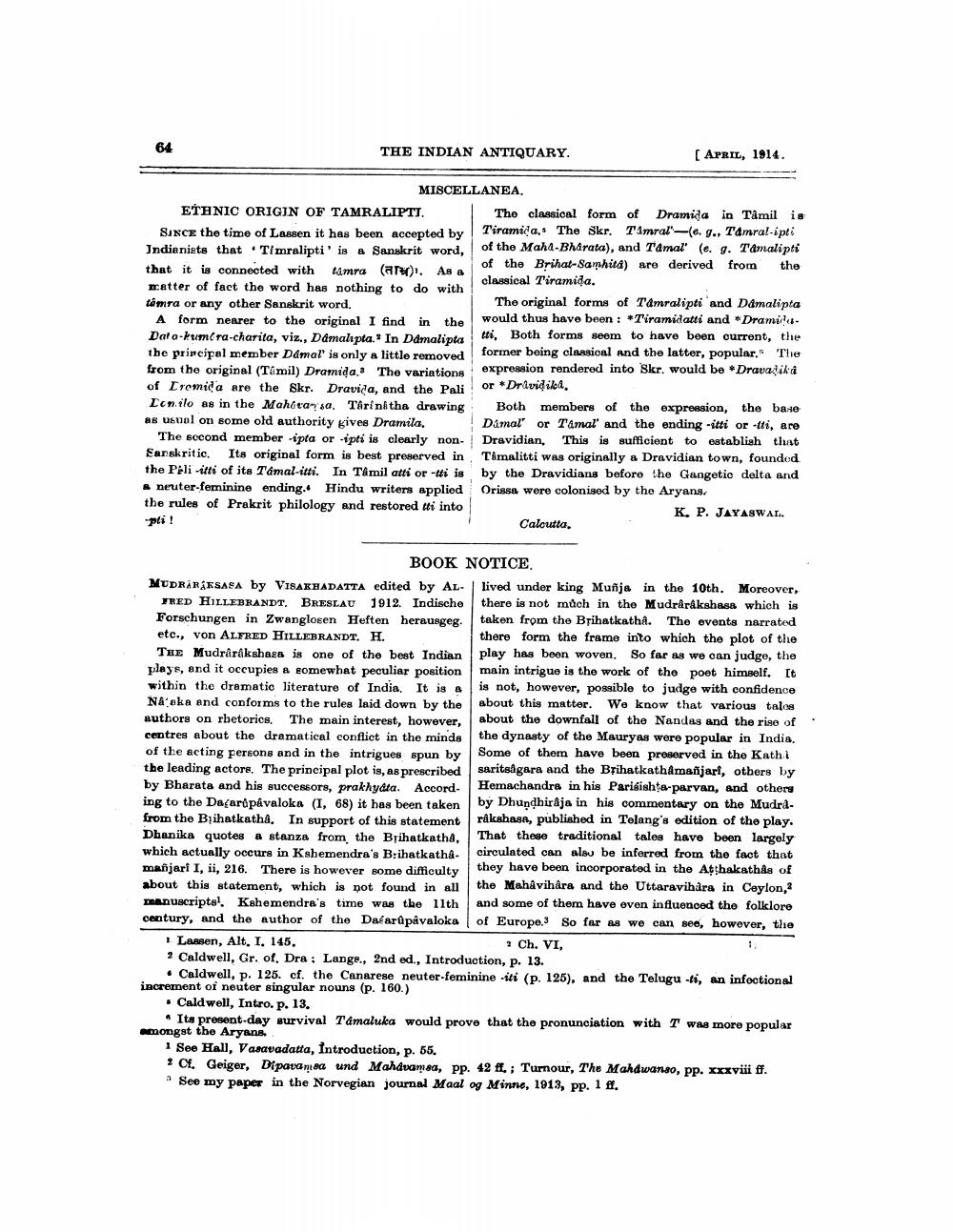________________
64
THE INDIAN ANTIQUARY.
[ APRIL, 1914.
MISCELLANEA. ETHNIC ORIGIN OF TAMRALIPTI.
The classical form of Dramida in Tamil is SINCE the time of Lassen it has been accepted by Tiramica, The Skr. Timral-(6. g., Tamral-ipti Indianists that • Timralipti' is a Sanskrit word,
of the Maha-Bharata), and Tamal' (e. g. Tamalipti
of the Brihat-Samhita) are derived from the that it is connected with lumra (ate). As a
classical Tiramida. matter of fact the word has nothing to do with támra or any other Sanskrit word.
The original forms of Tamralipti and Damalipta A form nearer to the original I find in the
would thus have been : *Tiramidatti and Drami. Data-tumora-charita, viz., Damalıpta. In Damalipta
ti, Both forms seem to have been current, the the principal member Damal' is only a little removed
former being classical and the latter, popular." The from the original (Tamil) Dramida, The variations expression rendered into Skr. would be Dravadika of Lremila are the Skr. Dravida, and the Pali! or Dravidiled. Lenilo as in the Mahacamaa. Tarinatha drawing Both members of the expression, the base as usual on some old authority kives Dramila, Damal' or Tamal' and the ending -itti ortti, are
The second member ipta or ipti is clearly non- Dravidian, This is sufficient to establish that Sanskritic. Its original form is best preserved in Tåmalitti was originally a Dravidian town, founded the Poli-itti of its Tamal-itti. In Tamil atti orti is by the Dravidians before the Gangetic delta and * neuter-feminine ending. Hindu writers applied Orissa were colonised by the Aryans. the rules of Prakrit philology and restored ti into
K. P. JAYASWAL. Caloutta.
pi!
BOOK NOTICE MUDRARAKSASA by VISAKHADATTA edited by AL- lived under king Munja in the 10th. Moreover,
FRED HILLEBRANDT, BRESLAU 1912. Indische there is not much in the Mudrárakshasa which is Forschungen in Zwanglosen Heften herausgeg. taken from the Brihatkatha. The events narrated etc., von ALFRED HILLEBRANDT, H.
there form the frame into which the plot of the THE Mudrirakshaga is one of the best Indian play has been woven. So far as we can judge, the plays, and it occupies a somewhat peculiar position main intrigue is the work of the poet himself. It within the dramatic literature of India. It is a is not, however, possible to judge with confidence Nå ska and conforms to the rules laid down by the about this matter. We know that various tales authors on rhetorics. The main interest, however,
about the downfall of the Nandas and the rise of centres about the dramatical conflict in the minds the dynasty of the Mauryas were popular in India. of the acting persons and in the intrigues spun by
Some of them have been preserved in the Kathi the leading actors. The principal plot is, as prescribed
saritsagara and the Brihatkathamañjarl, others by by Bharata and his successors, prakhydta. Accord
Hemachandra in his Paribishta-parvan, and others ing to the Daçarðpávaloka (1, 68) it has been taken
by Dhundhiraja in his commentary on the Mudrafrom the Bihatkatha. In support of this statement
råkshasa, published in Telang's edition of the play. Dhanika quotes a stanza from the Brihatkatha, That these traditional tales have been largely which actually occurs in Kshemendra's Bihatkatha.
circulated can also be inferred from the fact that Manjari I, ii, 216. There is however some difficulty
they have been incorporated in the Atthakathis of about this statement, which is not found in all the Mahâvihara and the Uttaravihåra in Ceylon, manuscriptst. Kshemendra's time was the 11th and some of them have even influenced the folklore century, and the author of the Dalar på valoka of Europe. So far as we can see, however, the • Lassen, Alt. I. 145.
1 Ch. VI, ? Caldwell, Gr. of. Dra: Lange., 2nd ed., Introduction, p. 13.
• Caldwell, p. 125. cf. the Canarese neuter-feminine -iti (p. 125), and the Telugu -ti, an infoctional increment of neuter singular nouns (p. 160.)
• Caldwell, Intro. p. 13.
• Its present-day survival Tamaluka would prove that the pronunciation with T was more popular amongst the Aryans.
1 See Hall, Vasavadatta, Introduction, p. 55.
Cf. Geiger, Dipavamsa und Mahavamsa, pp. 42 ff.; Turnour, The Mahdwanso, pp. xxxviii ff. * See my paper in the Norvegian journal Maal og Minne, 1913, pp. 1 ff.




